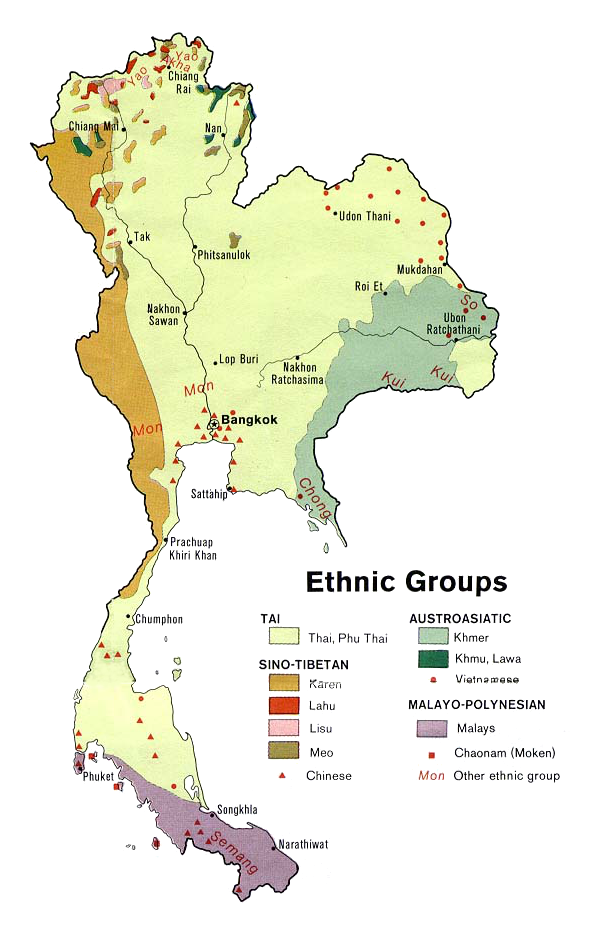 | ||
Thailand, and its neighbor Laos, are dominated by languages of the Southwestern Tai family. Karen languages are spoken along the border with Burma, Khmer is spoken near Cambodia and Malay in the south near Malaysia. The following table comprises all 62 ethnic groups recognised by the Royal Thai Government in the 2011 Country Report to the UN Committee responsible for the International Convention for the Elimination of All Forms of Racial Discrimination, available from the Department of Rights and Liberties Promotion of the Thai Ministry of Justice.
Contents
- Map of Thailand
- Thai
- Minority languages
- Tribal languages
- Sign language
- Most widely spoken language
- References
Map of Thailand
Five language families of Thailand recognised by the Royal Thai Government
The following table shows all the language families of Northeast Thailand, as recognised in the same report.
Language families of Northeast Thailand
Note that population numbers are for the Northeast region only. Languages may have additional speakers outside the Northeast.
The Thai hill tribes speak numerous small languages, many Chinese retain varieties of Chinese, and there are half a dozen sign languages. The Ethnologue reports 73 living languages are used in Thailand. The Royal Thai Government's 2011 Country Report to the Committee Responsible for the International Convention on the Elimination of All Forms of Racial Discrimination, relying mainly on the 2005 Ethnolinguistic Maps of Thailand data, lists 62 languages.
Thai
The official language of Thailand is Thai, a Siamese language closely related to Lao, Shan in Burma, and numerous smaller languages of southern China and northern Vietnam. It is the principal language of education and government and is spoken throughout the country. The standard is based on the dialect of Bangkok, and it is written in the Thai alphabet, an abugida that evolved from the Khmer script.
Several other Tai languages exist: Southern Thai is spoken in the southern provinces, and Lanna is spoken in the provinces that were formerly part of the independent kingdom of Lanna.
Minority languages
Thailand is also host to several minority languages. The largest minority language is Lao, a dialect of Isan spoken in the northeastern provinces. The region in where it is traditionally spoken was historically part of the Lao kingdom of Lan Xang.
In the far south, Yawi, a dialect of Malay, is the primary language of the Malay Muslims. Varieties of Chinese are also spoken by the large Thai Chinese population, with the Teochew dialect being best represented.
Tribal languages
Numerous tribal languages are also spoken, including those belonging to:
Sign language
Several village sign languages are reported among the hill tribes, though it is not clear whether these are independent languages, as only Ban Khor Sign Language has been described. Two related deaf-community sign languages developed in Chiangmai and Bangkok; the national Thai Sign Language developed from these under the influence of American Sign Language.
English is a mandatory school subject, but the number of fluent speakers remains very low, especially outside the cities.
Most widely spoken language
The following table shows official first languages in Thailand with equal to or more than 400,000 speakers according to the Royal Thai Government's 2011 Country Report to the Committee Responsible for the International Convention on the Elimination of All Forms of Racial Discrimination, mainly using the Ethnolinguistic Maps of Thailand data.
Official first languages of Thailand with equal to or more than 400,000 speakers
Languages in Thailand with more than 1 million speakers according to Ethnologue
The following table employs 2000 census data. Caution should be exercised with Thai census data on first language. In Thai censuses, the four largest Tai-Kadai languages of Thailand (in order, Central Thai, Isan (majority Lao), Kam Mueang, Pak Tai) are not provided as options for language or ethnic group. People stating such a language as a first language, including Lao, are allocated to 'Thai'. This explains the disparity between the two tables. For instance, self-reporting as Lao has been prohibited, due to the prohibition of the Lao ethnonym in the context of describing Thai citizens, for approximately one hundred years. This was due to the promotion of a 'Thai' national identity to cement Siamese claims over the Lao city-states of what is now Northern and Northeast Thailand following the 1893 Franco Siamese War and subsequent threat posed by French Indochina to Lao tributary states of Siam. The birth of a homogenizing Thai ethnocentric national identity sufficient to begin transforming Siam from an absolute monarchy into a modern nation-state was achieved by assimilating the Lao within this Thai 'identity', equivalent to what is now known as the Tai–Kadai_languages, under a 'Greater Thai Empire', and can be traced back to at least 1902. This homogenization began affecting the Thai census from 1904 onwards. The 2011 Country Report data is therefore more comprehensive and better differentiates between the large Tai-Kadai languages of Thailand. As a country submission to a UN convention ratified by Thailand, it is also arguably more authoritative.
